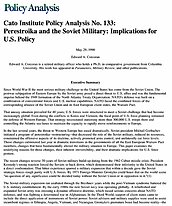That uneasy situation prevailed for 40 years; U.S. forces were structured to meet a Soviet challenge that had become increasingly global. Even during the conflicts in Korea and Vietnam, the focal point of U.S. force planning remained the defense of Western Europe. That strategy necessitated stationing more than 300,000 U.S. troops there and controlling the Atlantic sea-lanes to maintain the capacity to rapidly move reinforcements to Europe.
In the last several years, the threat to Western Europe has eased dramatically. Soviet president Mikhail Gorbachev initiated a program of perestroika–restructuring–that decreased the role of the Soviet military, reduced its resources, constrained the offensive aspects of its doctrine, actively promoted arms control, and unilaterally cut force levels. Those changes culminated last year in dramatic transitions in the governments of all the East European Warsaw Pact members, changes that have fundamentally altered the military situation in Europe. This paper examines the underlying reasons for those changes, their inherent irreversibility, and their dramatic implications for U.S. force posture.
The recent changes reverse 30 years of Soviet military build-up dating from the 1962 Cuban missile crisis. President Kennedy’s strong reaction forced the Soviets to back down, which demonstrated their inferiority to the United States in a direct confrontation. That bitter experience spurred a military expansion that within a decade gave the Soviet strategic forces rough parity with U.S. forces. By 1971 Foreign Minister Gromyko could boast that on the world scene “no question of any significance could be decided today without the Soviet Union or in opposition to it.”(1)
The Soviet military expansion ran unabated through the Brezhnev years while the post-Vietnam syndrome battered the U.S. military establishment. By the early 1980s the new Soviet navy was operating globally. A refurbished and expanded Soviet army was stressing a dynamic offensive doctrine, which raised serious concerns about NATO defenses, and was fighting a determined war in Afghanistan. In the Third World, support of client states came to include the direct application of instruments of Soviet power: Soviet advisers and military supplies were used to assist incumbent regimes in Ethiopia, Angola, Vietnam, and Nicaragua. Gromyko’s premature boast had become reality–the Soviet position on any question of global significance was indeed crucial; the Soviet Union shared superpower status with the United States.

